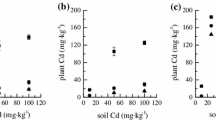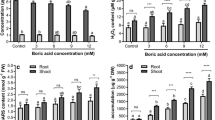Abstract
Seedlings of wheat (Triticum aestivum) were exposed in soil to the polycyclic musk chemical, 1,3,4,6,7,8-hexahydro-4,6,6,7,8,8-hexamethylcyclopenta[g]-2-benzopyran (HHCB) for 21 days, to evaluate its effect upon chlorophyll (CHL), lipid peroxidation and the antioxidant system. The content of CHL in leaves was inhibited significantly after 14- and 21-days exposures, whereas it was significantly induced by a low level of HHCB after a 7-days exposure. The content of malondialdehyde (MDA) in wheat leaves increased with an increase in the concentration of HHCB in soil, indicating that oxidative stress could be induced by HHCB. Moreover, HHCB exposure induced significant antioxidant responses in wheat. The activities of superoxide dismutase (SOD), catalase (CAT) and peroxidase (POD) in wheat leaves were induced by HHCB after 14 and 21 days of exposure. However, the changing trend of the antioxidant enzymes in wheat roots was different from that in leaves. The results suggested that the assayed parameters of T. aestivum could be used as responsive biomarkers for oxidative stress in the soil environment.





Similar content being viewed by others
References
Aina R, Labra M, Fumagalli P, Vannini C, Marsoni M (2007) Thiol-peptide level and proteomic changes in response to cadmium toxicity in Oryza sativa L. roots. Environ Exp Bot 59(3):381–392
Chen CH, Zhou QX, Bao YY, Li YN, Wang P (2010a) Ecotoxicological effects of polycyclic musk and cadmium on seed germination and seedling growth of wheat (Triticum aestivum). J Environ Sci 22(12):1966–1973
Chen CH, Zhou QX, Cai Z, Wang YY (2010b) Effect of soil polycyclic musk and cadmium on pollutant uptake and biochemical responses of wheat (Triticum aestivum). Arch Environ Contam Toxicol 59(4):564–573
Chen C, Xue SG, Zhou QX, Xie XJ (2011a) Multilevel ecotoxicity assessment of polycyclic musk in the earthworm Eisenia fetida using traditional and molecular endpoints. Ecotoxicology 20(8):1949–1958
Chen CH, Zhou QX, Zhang ZN, Cai Z (2011b) Effects of soil HHCB and Cd contamination on the growth of wheat seedlings (Triticum aestivum) and the pollutants accumulation in plants. Environ Sci 32:199–205 (in Chinese)
Chen CH, Zhou QX, Cai Z (2014) Effect of soil HHCB on cadmium accumulation and phytotoxicity in wheat seedlings. Ecotoxicology 23(10):1996–2004
Fatima RA, Ahmad M (2004) Certain antioxidant enzymes of Allium cepa as biomarkers for the detection of toxic heavy metals in wastewater. Sci Total Environ 346:256–273
Fridovich I (1995) Superoxide radical and superoxide dismutases. Annu Rev Biochem 64:97–112
Hertwing B, Streb P, Feieraband J (1992) Light dependence of catalase synthesis and degradation in leaves and the influence of interfering stress conditions. Plant Physiol 100:1547–1553
Kim W-K, Park J-W, Lim E-S, Lee S-K, Kim J, Kim S, Lee S-W, Chio K, Jung J (2014) Tissue-specific antioxidant responses in pale chub (Zacco platypus) exposed to copper and benzo[a]pyrene. Bull Environ Contam Toxicol 92:540–545
Kinney CA, Furlong ET, Kolpin DW, Burkhardt MR, Zaugg SD, Werner SL, Bossio JP, Benotti MJ (2008) Bioaccumulation of pharmaceuticals and other anthropogenic waste indicators in earthworms from agricultural soil amended with biosolid or swine manure. Environ Sci Technol 42(6):1863–1870
Li MH (2003) Peroxidase and superoxide dismutase activities in fig leaves in response to ambient air pollution in a subtropical city. Arch Environ Contam Toxicol 45(2):168–176
Lin RZ, Wang XR, Luo Y, Du WC, Guo HY, Yin DQ (2007) Effects of soil cadmium on growth, oxidative stress and antioxidant system in wheat seedlings (Triticum aestivum L.). Chemosphere 69(1):89–98
Litz N, Muller J, Bohmer W (2007) Occurrence of polycyclic musks in sewage sludge and their behaviour in soil and plants. J Soil Sediment 7(1):36–44
Liu S, Zhou QX, Wang YY (2011) Ecotoxicological responses of the earthworm Eisenia fetida exposed to soil contaminated with HHCB. Chemosphere 83:1080–1086
Liu WL, Zhang CB, Liu SY (2014) Effects of phthalate ester treatment on seed germination and antioxidant enzyme activities of Phaseolus radiatus L. Bull Environ Contam Toxicol 92(5):621–624
Luckenbach T, Epel D (2005) Nitromusk and polycyclic musk compounds as long-term inhibitors of cellular xenobiotic defense systems mediated by multidrug transporters. Environ Health Perspect 113(1):17–24
Migliore L, Godeas F, De Filippis SP, Mantovi P, Barchi D, Testa C, Rubattu N, Brambilla G (2009) Hormetic effect(s) of tetracyclines as environmental contaminant on Zea mays. Environ Pollut 158(1):129–134
Pedersen S, Selck H, Savito D, Forbes V (2008) Effects of the polycyclic musk HHCB on individual- and population- level endpoints in Potamopyrgus antipodarum. Ecotoxicol Environ Saf 72(4):1190–1199
Rimkus GG (1999) Polycyclic musk fragrances in the aquatic environment. Toxicol Lett 111(1–2):37–56
Sandalio LM, Dalurzo HC, Gómez M, Romero-Puertas MC, del Rio LA (2001) Cadmium induces changes in the growth and oxidative metabolism of pea plants. J Exp Bot 52:2115–2126
Verma S, Dubey RS (2003) Lead toxicity induces lipid peroxidation and alters the activities of antioxidant enzymes in growing rice plants. Plant Sci 164:645–655
Wang ME, Zhou QX (2006) Effects of herbicide chlorimuron-ethyl on physiological mechanisms in wheat (Triticum aestivum). Ecotoxicol Environ Saf 64(2):190–197
Yang JJ, Metcalfe CD (2006) Fate of synthetic musks in a domestic wastewater treatment plant and in an agricultural field amended with biosolids. Sci Total Environ 363(1–3):149–165
Acknowledgments
The authors acknowledge the financial support from the National Natural Science Foundation of China (Grant Nos. 21207068, 21037002 and U1133006).
Author information
Authors and Affiliations
Corresponding author
Rights and permissions
About this article
Cite this article
Chen, C., Cai, Z. Physiological and Antioxidant Responses in Wheat (Triticum aestivum) to HHCB in Soil. Bull Environ Contam Toxicol 95, 272–277 (2015). https://doi.org/10.1007/s00128-015-1565-x
Received:
Accepted:
Published:
Issue Date:
DOI: https://doi.org/10.1007/s00128-015-1565-x




